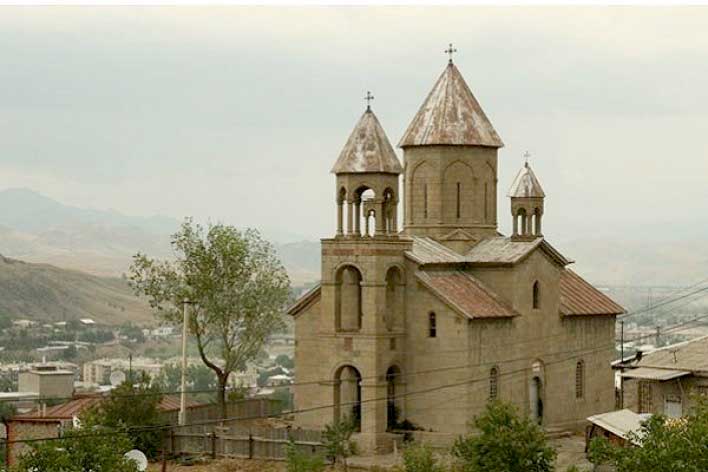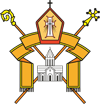AKHALTSIKHE SOURB NSHAN (ST. VARDANANTS) CHURCH
THE CHURCH WAS ESTABLISHED IN 1861-1862. IN 1970, THE CHURCH WAS PARTIALLY RENOVATED, IN 1980, IT WAS TURNED INTO A MUSEUM OF PEOPLE'S FRIENDSHIP. NOW IT IS IN POOR CONDITION AND BEHIND CLOSED DOORS.
Establishment: St. Vardanants (St. Nshan) church of Akhaltsikhe, which is still standing today, is located in the Marda (Marta) district of the same city, on the steep slope of a small hill [1]. The area where the St. Nshan church was built was named by the Armenian emigrants who migrated from Karin to Akhaltsikhe in 1829-1830, in memory of the sacred mountain near their former settlement [2]. The point is that the active Armenian church St. Savior (Sourb Prkich), operating in the city, was quite far from the Marda suburb, so the Armenian parishioners addressed the spiritual authorities with a request asking for permission to build a new church called St Nshan in the area. The permission to build St. Nshan church was given in 1861 [3], and the construction started in 1862. Akhaltsikhe honored citizen Vardan Vardanyants[4] took over the entire cost of construction.
The construction of the church took more than two years and was completed in 1864. On February 27 of the same year, in the presence of political and military officials, the Diocesan Primate, accompanied by the clergy, blessed and consecrated the church and “named it after the holy warrior and great martyr Vardan…”[5].
On the eastern facade of the church and the upper part of the southern entrance, the inscriptions about the construction have also been preserved.[6]
Architecture: St. Nshan church is a three-nave central-domed building with an architectural design of an external rectangular plan. The hexagonal drum, ending with a pointed gable, is supported internally by vaulted arches resting on two pairs of round columns. Three entrances are opening from the north, south, and west facades. Adjacent to the western facade is the three-storied belfry, standing on four columns on the first and second floors and on six columns on the third. it is built of stones, plastered inside. External dimensions are 15.35 x 10.83 m.[7].
Clergy: Among priests of St. Nshan were priest Rev. Father Hovhannes Arvanyants[8], senior priest Rev. Father Hovhannes Ter-Margaryants[9], Rev. Fathers Tigran Sisakyants[10], Minas Aznavuryants[11], Gevorg Ter-Karapetyan Sisakyants[12].
Economic condition: St. Nshan (St. Vardanants) church had a number of properties and buildings belonging to the church, about which there are many facts.
A garden with fruit trees, arable land, and houses belonged to the church. Remarkable information about the church’s immovable properties was preserved in the list of church immovable properties list issued on June 17, 1886[13]. In addition to immovable properties, St. Nshan church also had many precious jewels and vessels[14]. At the beginning of the 20th century the church had a garden and two houses in the new part of the city. The main amount of the church was about 360 rubles and 73 kopecks, the amount received from properties: 694 rubles and 28 kopecks, and expenditure: 672 rubles and 34 kopecks. A house on Aleksandrian Street was added to the former properties, which was donated to the church by the local branch of the Caucasian Charity Society[15]. St. Nshan church, thanks to various benefactors and donations, was able to acquire new properties and wealth regularly, which were mentioned in the lists of immovable and movable properties issued in different periods[16].
School: The construction of the St. Nshan church’s parish school is again connected with the name of the Vardanyants family. Particularly, in 1864, father and son Vardanyants wrote related to the building of a school next to the church: "...wanting to build a new room in the wall for the national school for hundreds of children lived in that place, who because of the long distance could not come to the other big school in our city and remained without the knowledge of faith" [17]. Hamazasp Vardanyants, spending 8000 rubles from his own funds, built the school and undertakes the maintenance of the institution, which required an annual expenditure of about 1000 rubles[18].
Among the teachers who taught at the school were Hovhannes Hakobyants, Melkisedek Mkrtchyan, Tigran Sisakyants, Ghazaros Baghdasaryants, priest Martiros Metsatunyants and others[19]. Hamazasp Vardanyants and his assistant Grigor agha Saghoyants are mentioned among the trustees of the school. The school of St. Nshan church was closed in 1884 [20].
Church in the Soviet period: Despite a document, according to which the church's closure dates back to 1928[21], the church was officially closed in 1938, although its doors were open to the faithful until 1941.
In 1957, the Prelate of the Armenian Diocese in Georgia addressed a number of statements and petitions to the authorities and First Catholicos Vazgen regarding the reopening of St. Vardanants church. Already in March, in a confidential report sent to V. Gostev, the head of the Council of Religious Affairs under the Council of Ministers of the USSR, Shalutashvili, an authorized person of the same council operating in Georgia, mentioned that "...the Armenian St. Nshan church of Akhaltskha was built in 1840. The church building occupies an area of 107 square meters. From the moment the church was closed, it is used as a regional archive[22]”. At the same time, he adds that the Prelate of the Armenian Diocese in Georgia Kalantaryan is spreading agitation among the faithful Armenians in different regions of the republic urging them to submit statements to the authorities to reopen the church. It should be mentioned that in 1956, the Akhaltskhe regional executive committee installed special two-story wooden shelves for archive works inside the church building, as well as built an office for the employees of the regional archive, spending about 15 thousand rubles [23].
In the 1970s, the church was partially renovated, as a result of which the inscription on the northern entrance wall (tympanum) disappeared[24].
In 1976-78, the church was cleansed by the Armenian society and the priests of St. Gregory the Illuminator church, brothers Ter Ruben and Ter Shmavon Sadoyans, who were punished by the authorities. Alas, the church was never returned to the people and turned into an ethnographic museum. Later, on April 24, 1989, the Response for Souls service offered in the church with the participation of the local clergymen and the Armenian population became the reason for the dispute between the Armenian and Georgian populations of the city. With the involvement of the Armenian and Georgian authorities and intellectuals of the time, it was decided to keep the doors of the church equally open to both communities until the final solution of the issue.
This decision was supported by the opinion of some Georgian scholars that St. Nshan church was built on the foundations of a Georgian church. Unfortunately, it should be mentioned that some of the Georgian intellectuals and clergy are trying to spread this misconception to other churches of Armenian origin in Georgia.
[1]During the Soviet years, the church was also named St Nshan.
[2]NAA, ֆ. 53, ց. 1, գ. 2253, թ. 271 շրջ.-272:
[3]NAA, ֆ. 53, ց. 1, գ. 2252, թ. 104:
[4] I. Hazarapetiants, The consecration ceremony of Saint Vardana church in Akhaltskha “Meghu Hayastani” weekly newspaper, 1864, № 18, p. 148:
[5]I. Hazarapetiants, the mentioned article., p. 149:
[6]The text of the protocols, see: S. Karapetyan, Akhaltskha, Yerevan, 2008, p. 136: In order to make the inscription more readable, in 2002 the local Armenians covered the recesses of the letters with black paint.
[7]S. Karapetyan, the mentioned work., p. 135:
[8] A. Yeritsyan's archive, paper 157, doc. 276, թ. 52:
[9]NAA, ֆ. 53, ց. 1, գ. 550, թթ. 16-17:
[10]ՄՄ, Կ/դ, թղթ. 202, վավ. 502, original, manuscript
[11]NAA, ֆ. 53, ց. 1, գ. 566, թթ. 1-2:
[12]NAA, ֆ. 53, ց. 1, գ. 795, թ. 29:
[13]NAA, ֆ. 53, ց. 1, գ. 944, թ. 30: The same properties are also mentioned in 1898. in the property list of the church issued on May 3, (NAA, ֆ. 53, ց. 1, գ. 1218, թ. 2 և շրջ.):
[14]NAA, ֆ. 53, ց. 1, գ. 1240, թթ. 10-13:
[15]NAA, ֆ. 53, ց. 1, գ. 1240, թ. 9 շրջ.:
[16]NAA, 355, ց. 2, գ. 405, թ. 3 և շրջ:
[17] A. Yeritsyan's archive, paper 157, doc. 275, թ. 51:
[18]NAA, ֆ. 355, ց. 1, գ. 329, թ. 3:
[19] “Meghu Hayastani” weekly newspaper, 1869, № 28, p. 219:
[20] “Meghu Hayastani” weekly newspaper, 1884, № 61, p. 4:
[21]NAA, ֆ. 409, ց. 1, գ. 3217, թ. 1 և շրջ.:
[22]NAA, ֆ. 823, ց. 3, գ. 119, թ. 12.: Of course, the date of the church's construction is wrong.
[23]NAA, ֆ. 823, ց. 3, գ. 119, թ. 12.: See also "Banber of Armenian Archives", 2001, № 1, p. 91:
[24]S. Karapetyan, A. Marutyan, R. Naatakyan, St. Vardanants (St. Nshan) church of Akhaltskha (documents), “News of social sciences”, 1990, № 5, p. 85:
 Հայերեն
Հայերեն  ქართული
ქართული  English
English  Русский
Русский 


